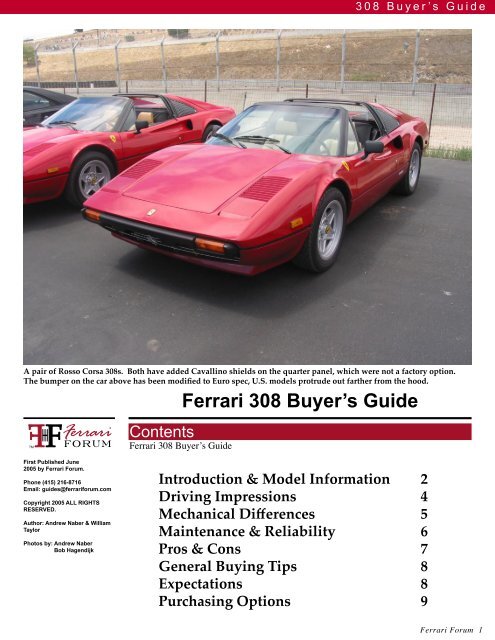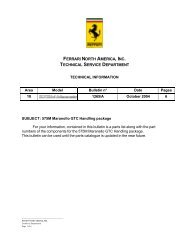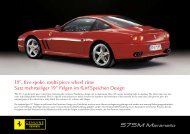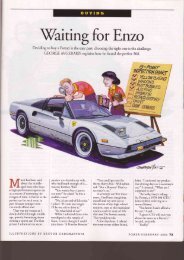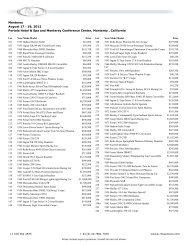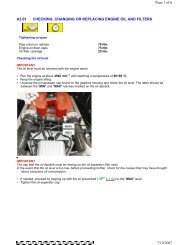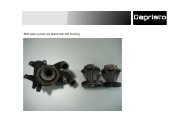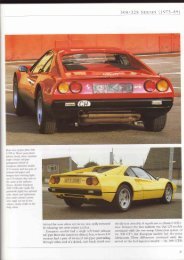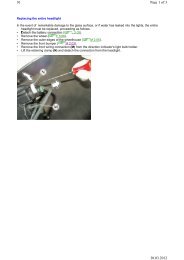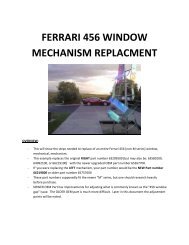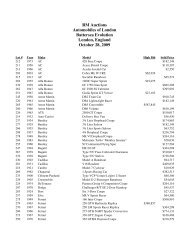Ferrari 308 Buyer's Guide - Ferrari Life
Ferrari 308 Buyer's Guide - Ferrari Life
Ferrari 308 Buyer's Guide - Ferrari Life
Create successful ePaper yourself
Turn your PDF publications into a flip-book with our unique Google optimized e-Paper software.
3 0 8 B u y e r ’ s G u i d e<br />
A pair of Rosso Corsa <strong>308</strong>s. Both have added Cavallino shields on the quarter panel, which were not a factory option.<br />
The bumper on the car above has been modified to Euro spec, U.S. models protrude out farther from the hood.<br />
TM<br />
F<br />
F <strong>Ferrari</strong><br />
forum<br />
First Published June<br />
2005 by <strong>Ferrari</strong> Forum.<br />
Phone (415) 216-8716<br />
Email: guides@ferrariforum.com<br />
Copyright 2005 ALL RIGHTS<br />
RESERVED.<br />
Author: Andrew Naber & William<br />
Taylor<br />
Photos by: Andrew Naber<br />
Bob Hagendijk<br />
Contents<br />
<strong>Ferrari</strong> <strong>308</strong> Buyer’s <strong>Guide</strong><br />
<strong>Ferrari</strong> <strong>308</strong> Buyer’s <strong>Guide</strong><br />
Introduction & Model Information 2<br />
Driving Impressions 4<br />
Mechanical Differences 5<br />
Maintenance & Reliability 6<br />
Pros & Cons 7<br />
General Buying Tips 8<br />
Expectations 8<br />
Purchasing Options 9<br />
<strong>Ferrari</strong> Forum 1
F e r r a r i F o r u m - w w w . f e r r a r i f o r u m . c o m<br />
Model Information<br />
How successful was the<br />
<strong>308</strong>? Thirty years a�er its launch,<br />
it is still the model that first comes<br />
to mind when most people think<br />
of a <strong>Ferrari</strong>. The launch of the <strong>308</strong><br />
at the Paris Auto Show in 1975<br />
marked a dramatic permanent shi�<br />
in the <strong>Ferrari</strong> philosophy. It was<br />
the first production car to carry<br />
the <strong>Ferrari</strong> badge at launch that<br />
was not powered by a 12 cylinder<br />
engine. Initial press reaction to the<br />
<strong>308</strong> was very positive.<br />
The <strong>308</strong> was the first <strong>Ferrari</strong><br />
road car to sport a fiberglass<br />
body. It is commonly believed<br />
that fiberglass was used in order<br />
to get the new model to market<br />
quickly as the <strong>308</strong> GT4 was not<br />
selling well. It was quicker to make<br />
the moulds for fiberglass than the<br />
dies needed for the metal panels.<br />
The first 712 units were made this<br />
way before the switch back to steel<br />
bodies in 1976. The change to steel<br />
might also have been influenced by<br />
a perceived negative reaction to a<br />
“plastic” <strong>Ferrari</strong> in the US market.<br />
The <strong>308</strong> marked the return,<br />
a�er the brief foray to Bertone for<br />
the <strong>308</strong> GT4, to Pininfarina for the<br />
design. Pininfarina did a masterful<br />
job incorporating elements<br />
of both the Dino 246 and the 512<br />
Berline�a Boxer. The end result<br />
is a design which clearly fits into<br />
the <strong>Ferrari</strong> line both as an evolution<br />
of the Dino 246 and as a junior<br />
stable mate for the Boxers. The<br />
wedge nose is a clear adaptation<br />
from the Boxer whiles the wrap<br />
around rear window, wheel arches,<br />
and recessed air intakes running<br />
along the doors, are clearly evolutions<br />
from the Dino. Overall the<br />
<strong>308</strong> is a wonderful design which<br />
flows smoothly as the eye moves<br />
across the car. With the exception<br />
of minor updating with the<br />
launch of the 328 in 1985, the basic<br />
design remained unchanged for a<br />
remarkable 15 years. By the end<br />
2 <strong>Ferrari</strong> Forum<br />
of the production run in 1985, the<br />
<strong>308</strong> was by far the most successful<br />
<strong>Ferrari</strong> to date with close to 14,000<br />
cars produced. As a reference less<br />
than 2,500 Boxers were produced<br />
in its 10 year production run.<br />
The <strong>308</strong> went through<br />
several major changes during its<br />
long run. These will be covered in<br />
detail in the next section. The most<br />
significant changes were the move<br />
from fiberglass to steel bodies in<br />
1976, the launch of the GTS with a<br />
removable roof panel in 1977, the<br />
adoption of fuel injection in 1980<br />
on the <strong>308</strong> GTBi/GTSi, and the<br />
move from a 2 to a 4 valve engine<br />
with the Qua�rovalvole in 1983.<br />
In general US <strong>308</strong> models can be<br />
identified by their heavy protruding<br />
bumpers, rectangular side<br />
markers, and the exhaust shield.<br />
The basic mechanicals of<br />
the <strong>308</strong> are a mid-engine configuration<br />
using a quad cam 90 degree<br />
V8 si�ing transversally behind the<br />
cabin mated to a 5-speed manual<br />
gearbox. Camsha�s were beltdriven,<br />
and power was taken by a<br />
dry plate clutch mounted on the<br />
flywheel and delivered through<br />
all synchromesh indirect gears. A<br />
front-mounted radiator with twin<br />
fans vented engine cooling air<br />
though the bonnet louvres while<br />
side intakes just rear of the doors<br />
provided for engine and oil-cooler<br />
airflows. For the first five years,<br />
four twin throat Weber carburetors<br />
feed the 3 liter engine. Fuel<br />
injection was adopted in 1980 to<br />
meet ever increasing US emission<br />
standards.<br />
The chassis is welded<br />
tubular steel and this created a<br />
stiff and robust vehicle. The floor<br />
pan and inner wheel arches are<br />
fiberglass. Suspension is independent<br />
unequal length A arms with<br />
tubular shock absorbers and antiroll<br />
bars. Steering was via direct<br />
rack-and-pinion and brakes were<br />
all-wheel disks with power assistance.<br />
The gear change can be stiff<br />
and requires focus to slot properly.<br />
Windows on all <strong>308</strong> are electric<br />
and seats are trimmed in leather,<br />
adjustable fore and a�, with tiltable<br />
back rests and head rests. The<br />
wheel base was 8 inches shorter<br />
than the <strong>308</strong> GT4 and identical<br />
to the Dino 246. Luggage space<br />
was provided in the rear of the<br />
car behind the engine. A zippered<br />
cover protected contents from<br />
the engine. A spare tire was fi�ed<br />
in the front of the car behind the<br />
radiators. The fuel cap is mounted<br />
on the le� rear quarter panel and<br />
feeds twin 37 liter tanks. It is the<br />
last <strong>Ferrari</strong> designed for drivers<br />
under six feet tall.<br />
Model Information<br />
<strong>308</strong> GTB/GTS (1975-1980)<br />
The first <strong>308</strong>’s launched<br />
in 1975 shared the 3 liter engine<br />
with the <strong>308</strong> GT4. It was feed by<br />
four twin throat Weber carburetors<br />
and produced 255 bhp at<br />
7700 rpm. The first 712 cars were<br />
produced with Fiberglass bodies<br />
and weighed in at a svelte 2745 lbs.<br />
European models had dry sump<br />
lubrication with US models being<br />
supplied with wet sump systems.<br />
US models were 200 lbs heavier<br />
and lost 20 bhp to emissions<br />
requirements. As of 1976 steel<br />
bodies were supplied with US cars<br />
with all European models switching<br />
to steel in 1977. The steel<br />
bodies were not rust proofed until<br />
1984. 1977 also saw the introduction<br />
of the GTS with a fiberglass,<br />
vinyl covered, removable roof<br />
panel. The panel was a�ached via<br />
two center catches and stowed behind<br />
the seats. The GTS also had<br />
vertically sla�ed hinged covers on<br />
the rear quarter windows. European<br />
models had a single tail exhaust<br />
pipe while all US cars had a pair.
A Rosso Corsa <strong>308</strong> GTS (le�) and a Blu Chiaro <strong>308</strong> GTB (right). The <strong>308</strong> has a timeless design<br />
<strong>308</strong> GTBi/GTSi (1980-1983)<br />
The “i” series introduced<br />
several major changes to the <strong>308</strong>.<br />
Most significantly, the weber carbs<br />
were dropped in favor of Bosch K<br />
Jetronic fuel injection. Marelli electronic<br />
ignition was also adopted<br />
and an air pump added. Together<br />
these changes delivered a much<br />
smother and cleaner running engine<br />
which more easily meet ever<br />
increasing emission standards.<br />
On the negative, the “i” series lost<br />
30 bhp, with US cars delivering<br />
a un-<strong>Ferrari</strong> like 205 bhp at 6600<br />
rpm. All “i” series cars used a<br />
wet sump lubrication system and<br />
had a reputation for consuming<br />
large amounts of oil. Twin exhaust<br />
pipes were fi�ed to both US and<br />
European models at this point. A<br />
redesigned, lighter clutch was also<br />
fi�ed. With the addition of fuel<br />
injection and the lighter clutch, the<br />
“i” series was a less demanding car<br />
than the original. Several changes<br />
were made to the instrument panel<br />
with the gauges being rearranged<br />
to provide be�er visibility. The<br />
seats were also modified to increase<br />
lateral support and larger<br />
metric wheels were fi�ed.<br />
Vehicle performance under<br />
emission constraints was clearly<br />
an issue recognized by <strong>Ferrari</strong> and<br />
significant advancements were<br />
made to address this through the<br />
remainder of the model series.<br />
<strong>308</strong> GTB QV/GTS QV (1983-1985)<br />
The first major power boost<br />
was made through the introduction<br />
of the “qua�rovalvole” 4-valve<br />
per cylinder engine in 1983. The<br />
“QV” retained the 3 litre block of<br />
the <strong>308</strong> “i” but added 2 valves and<br />
moved from iron to Nikasil faced<br />
cylinder liners. All this resulted in<br />
increased output to a more <strong>Ferrari</strong><br />
like 240 bhp at 7000 rpm. The<br />
ignition was upgraded to Marelli<br />
3 0 8 B u y e r ’ s G u i d e<br />
Digiplex.<br />
Although in appearance the<br />
QV resembled the pervious model,<br />
<strong>Ferrari</strong> incorporated numerous<br />
improvements to systems and interior.<br />
These included a reworked<br />
console, and a new Momo steering<br />
wheel design. Apart from the<br />
badging, the model is identified by<br />
the prominent red-finished alloy<br />
intake plenum with emblazoned<br />
“Quatrovalvole”, driving lights<br />
mounted in the front grill, and a<br />
small spoiler mounted between<br />
the two sail panels behind the roof,<br />
like the 12 cylinder Boxers. Twin<br />
side mirrors were also now standard<br />
and sported the <strong>Ferrari</strong> shield<br />
on the front cone. Late QV’s also<br />
received rust proofing for the first<br />
time. The GTS outsold the GTB by<br />
4 to 1.<br />
<strong>Ferrari</strong> Forum 3
F e r r a r i F o r u m - w w w . f e r r a r i f o r u m . c o m<br />
The Special Italian Market Cars<br />
– 208 GTB, 208 GTS, 208 GTB<br />
Turbo, 208 GTS Turbo<br />
In 1980 <strong>Ferrari</strong> introduced<br />
a special line of cars for the Italian<br />
market to circumvent punitive<br />
taxes on all cars with engines over<br />
2 liters. These cars were identical<br />
to the contemporary <strong>308</strong> line with<br />
the exception that the engines were<br />
bored out to only 1990 cc. The<br />
first two models in this line were<br />
badged the 208 GTB and 208 GTS.<br />
These were the last <strong>Ferrari</strong>’s to be<br />
produced with Weber Carburetors<br />
and delivered 155 bhp at 6800 rpm.<br />
Top speed was a 215 kph. A total<br />
of 300 208s were produced<br />
To increase performance,<br />
<strong>Ferrari</strong> added a single exhaust<br />
drive KKK turbo charger to the<br />
208’s in 1982. These cars also received<br />
Bosch K Jetronic fuel injection.<br />
Performance increased to 220<br />
bhp at 7000 rpm which delivered a<br />
top speed of 242 kph. 687 208 Turbos<br />
were produced between 1982<br />
and 1986.<br />
In general the Italian market<br />
cars can be differentiated vs the<br />
<strong>308</strong> by the NACA scoop in front of<br />
the rear tires, raised center section<br />
on the engine lid, and slo�ed rear<br />
bumpers. All Turbo cars had the<br />
rear roof spoiler. A few of these<br />
cars can now be found in other European<br />
markets and it is believed<br />
4 <strong>Ferrari</strong> Forum<br />
a couple have made it into North<br />
America. The driving experience<br />
on the Turbos is a bit more raw vs<br />
the base <strong>308</strong>’s. Managing the Turbo<br />
boost presents an additional challenge<br />
for the driver.<br />
Driving Impressions<br />
Driving a <strong>308</strong> GTB followed<br />
by a <strong>308</strong> QV is an adventure<br />
in <strong>Ferrari</strong> evolution. The former<br />
represents the twilight years of<br />
the Carburetor era while the la�er<br />
is firmly routed in the modern<br />
fuel injected era. Despite this, the<br />
driving experience is remarkably<br />
similar. All <strong>308</strong>s handle exceptionally<br />
well and go immediately<br />
where pointed. It is a pure driving<br />
experience, as enjoyable today as it<br />
was 30 years ago.<br />
At start up, the <strong>308</strong> is a bit<br />
cranky until it warms up properly.<br />
The steering is heavy at low speeds<br />
but lightens up and becomes much<br />
more responsive as you accelerate.<br />
The short wheel base, coupled<br />
with the stiff chassis, results in<br />
excellent handling and feedback.<br />
A <strong>308</strong> is much happier on smooth<br />
road surfaces and does not react<br />
well to bumps and potholes.<br />
However it is exceptionally<br />
well balanced with very high<br />
limits. A <strong>308</strong> is a car that looks for<br />
mountain roads so it can show off<br />
its talents. The engine is flexible<br />
and power delivery is impressively<br />
linear up to the 7700 rpm redline.<br />
Give the accelerator a push, and<br />
you receive a return shove into the<br />
seat back. The more you push it,<br />
the be�er it gets and the be�er it<br />
sounds. The sound track on the<br />
initial <strong>308</strong>’s is probably the most<br />
impressive, but the <strong>308</strong> QV’s song<br />
will still get the neighbor’s a�ention.<br />
The clutch on the carbureted<br />
<strong>308</strong>’s is heavy and takes experience<br />
to master. However the carb<br />
cars are fi�ed with a shorter stick<br />
which does help with quick throws<br />
around the gate. With the switch<br />
to fuel injection with the <strong>308</strong>i a<br />
lighter clutch was fi�ed and this<br />
makes running the gearbox on the<br />
later models a joy. In both cases<br />
a rewarding clank signals a successful<br />
transition through the open<br />
steel gate. The 5 speed gearbox is<br />
set up in a racing pa�ern with 1st<br />
gear down and to the le�.<br />
A slight understeer is<br />
designed into the car to offset<br />
the weight and placement of the<br />
engine. The suspension is highly<br />
competent, keeping the car flat<br />
when cornering. The brakes are<br />
impressive at shedding speed<br />
rapidly and provide instant response<br />
and solid feedback. The<br />
switch gear on the <strong>308</strong> series is<br />
vintage 1970’s with a multitude of
toggle switches and sliding arms.<br />
With the <strong>308</strong>i & QV, minor updates<br />
were made to the interior, steering<br />
wheel, and seats.<br />
Inside, the driving position<br />
is classic Italian; long arms and<br />
short legs with the pedals offset<br />
towards the center of the car. The<br />
cabin itself is snug but the lack of a<br />
Units<br />
<strong>308</strong> GTB Fiberglass 712<br />
<strong>308</strong> GTB Steel 2185<br />
<strong>308</strong> GTS 3219<br />
<strong>308</strong> GTBi 494<br />
<strong>308</strong> GTSi 1749<br />
<strong>308</strong> GTB QV 748<br />
<strong>308</strong> GTS QV 3042<br />
transmission tunnel does provide a<br />
feeling of greater space. The seats<br />
move horizontally and the back<br />
rest angle is adjustable. It is a comfortable<br />
car for short to medium<br />
journeys, but over longer trips, the<br />
seats can become unforgiving. It<br />
is also not a quiet cabin and large<br />
investments in stereo equipment<br />
<strong>308</strong><br />
Engine Rear-mounted 90° V8<br />
Timing gear 2 valves per cylinder, twin overhead camshafts per cylinder bank<br />
Bore and Stroke 81 x 71 mm<br />
Displacement 2927 cc<br />
Compression ratio 8. 8:1<br />
Engine Lubrication Dry Sump (Europe) Wet Sump (US)<br />
Maximum power 255 bhp (235 bhp US) at 7,700 rpm<br />
Max engine speed 7700 rpm<br />
Transmission Single dry-plate clutch, 5-speed gearbox + reverse, limited-slip differential<br />
Chassis Tubular Steel<br />
Front & Rear suspension Independent, unequal length A arms, coil springs<br />
Wheelbase, front and rear track 2,340/1,460/1,460 mm<br />
Kerb weight 1,300 kg (GTB)<br />
Top Speed 252 km/h<br />
i (changes from <strong>308</strong>)<br />
Maximum power 214 bhp (205 bhp US) at 6,600 rpm<br />
Max engine speed 6600 rpm<br />
Engine Lubrication Wet Sump<br />
Kerb weight 1320 kg (GTB)<br />
Top Speed 240 kph<br />
QV (where different from i)<br />
Compression ratio 9.2:1<br />
Timing gear 4 valves per cylinder, twin overhead camshafts per cylinder bank<br />
Maximum power 240 bhp (230 US) at 7,000 rpm<br />
Kerb weight 1265 kg<br />
Top Speed 246 km/h<br />
3 0 8 B u y e r ’ s G u i d e<br />
are wasted.<br />
Of the three <strong>308</strong>’s, the <strong>308</strong><br />
is the most raw and requires the<br />
greatest amount of skill on the<br />
part of the driver. The <strong>308</strong> QV addresses<br />
many of the issues found<br />
in the <strong>308</strong>i while maintaining its<br />
strengths and appeal. It is also the<br />
most livable for everyday driving.<br />
<strong>Ferrari</strong> Forum 5
F e r r a r i F o r u m - w w w . f e r r a r i f o r u m . c o m<br />
Maintance & Reliability<br />
Common issues are few for the <strong>308</strong>/328’s as<br />
most of the early “new car” problems would have<br />
been sorted out long ago. Several areas of weakness<br />
that seem to be fairly widespread are:<br />
• Clutches can wear rapidly, due to the tall gearing.<br />
• Second gear will not engage when the engine is<br />
cold (typical all <strong>Ferrari</strong>s of this era)<br />
• Air conditioning systems need regular a�ention<br />
• Camsha� oil seals leaks, must be checked from<br />
under the car<br />
• Paint work is fragile and chips easily<br />
• Electrical / fuse box / relay problems on early<br />
models, very slow windows can be an indication of<br />
more serious issues<br />
• Coolant expansion tank corrosion<br />
• Fragile ignition-key/turn-indicator assembly<br />
• Rust on the lower rocker panels, door sills and<br />
around the wheel arches<br />
• Air pumps get disconnected and rust internally<br />
6 <strong>Ferrari</strong> Forum<br />
Other potential issues:<br />
• Tires for all the <strong>308</strong> models are rare and can be<br />
expensive to replace<br />
• Exhaust systems can suffer corrosion<br />
• Coolant system hoses can become frayed on fittings,<br />
etc.<br />
• Oil Pressure/Temp sender failures<br />
• Burned out catalytic converters on <strong>308</strong>’s and<br />
<strong>308</strong>i’s<br />
• Electrical switch problems (boot/bonnet/engine/<br />
glovebox/windows/aerial/etc)<br />
• Headlights are prone to freezing if not used regularly<br />
• Cold start smoke, piston sealing problems<br />
• Accident damage and improper repair<br />
• Suspension degrades and can seize if not used<br />
regularly<br />
• Broken door handles on <strong>308</strong>s<br />
• Window motors freezing<br />
• Speedometer sending unit failures<br />
• Marelli electronic ignition failure. Replacement is<br />
difficult as it is no longer produced.<br />
As a rough guideline, plan an annual budget of $1,000<br />
for service and minor issue recertification.
3 0 8 B u y e r ’ s G u i d e<br />
An early <strong>308</strong> GTS with a�ermarket wheels. The Cavallino shield was added by the owner and was not an option<br />
Pros & Cons<br />
PROS<br />
• One of the best values in the <strong>Ferrari</strong> world<br />
• All models fully depreciated and fairly pricestable<br />
• A real useable <strong>Ferrari</strong>, with proper maintenance,<br />
still can be used as a daily driver.<br />
• Great visibility for all driving conditions<br />
• Stability at speed and under brakes<br />
• Useable luggage space<br />
• A great driver’s car<br />
• The <strong>Ferrari</strong> in most peoples minds<br />
• Still well supported by official and independent<br />
dealers. Most parts are still easliy available.<br />
CONS<br />
• Off-line performance on the “i”<br />
• No power steering, heavy at low speeds and<br />
around town<br />
• Clutch and gearbox on early <strong>308</strong>’s require significant<br />
leg and arm strength<br />
• Large glass area requires good air-conditioned<br />
performance<br />
• Unlikely to appreciate in value<br />
<strong>Ferrari</strong> Forum 7
F e r r a r i F o r u m - w w w . f e r r a r i f o r u m . c o m<br />
General Buying Tips<br />
1. Demand to see the Service book and Maintenance History file. Make sure you have solid answers to<br />
any major holes in the history. If not, move on. Look specifically for missed cambelt changes. Many owners<br />
could afford to buy but not properly service the cars.<br />
2. Get the car inspected by a <strong>Ferrari</strong> trained mechanic. He will find things you miss. Given the age of all<br />
<strong>308</strong>’s this is absolutely critical.<br />
3. If the asking price is very low, there is a reason for it. Major work on a <strong>308</strong> can easily exceed the purchase<br />
price of the car.<br />
4. Carefully check the mileage against the history file. It is easy to disconnect the speedometer on a <strong>308</strong><br />
and many low mileage cars are not what they appear.<br />
5. Check the car carefully for rust. Rust proofing was not provided by the factory until 1984 and almost<br />
all <strong>308</strong>’s produced before this time will have some rust. On early Fibergalss <strong>308</strong>’s, check the body carefully for<br />
signs of accident damage and poor repair jobs.<br />
6. Never buy the first car you see, look and test drive several. If possible drive at least several different<br />
versions (recommendation is a <strong>308</strong> or a <strong>308</strong>i, and then a <strong>308</strong> QV). Preference among the three variants is highly<br />
subjective.<br />
7. Make sure the car has all the original Books, Tools, and Records. These are very expensive to replace<br />
later.<br />
8. Talk to other owners, join the <strong>Ferrari</strong> Forum.<br />
9. Talk to the Mechanics that have historically serviced the car. If possible also contact prior owners.<br />
Expectations<br />
When you purchase a <strong>Ferrari</strong>,<br />
you are not buying a car but<br />
rather a work of engineering art<br />
and a piece of history. A <strong>Ferrari</strong><br />
has a soul and character unique in<br />
the automotive world. A <strong>Ferrari</strong><br />
comes filled with Italian passion,<br />
for both be�er and occasionally<br />
worse. Driving a <strong>Ferrari</strong> is never<br />
boring. It is engaging. You are<br />
always involved and interacting<br />
with the car across a multitude<br />
of senses. While driving, this<br />
includes the constantly changing<br />
sound track as the engine moves<br />
through the rpm range, the heavy<br />
but exact clutch, and the metallic<br />
click with every gear change.<br />
There really is nothing else on the<br />
road that sounds like a <strong>Ferrari</strong>.<br />
8 <strong>Ferrari</strong> Forum<br />
Until you have driven one, it is impossible<br />
to appreciate the totality<br />
of the experience. It is this emotional<br />
link between car and owner<br />
that sets <strong>Ferrari</strong>’s apart from other<br />
sports cars<br />
Two other cars that many<br />
first time <strong>Ferrari</strong> owners consider<br />
are Lamborghini and Porsche.<br />
Lamborghini has similar roots in<br />
the Modena area . It however does<br />
not have the racing heritage or, for<br />
the majority of its life, the single<br />
minded guidance of a brilliant<br />
owner. Lamborghini’s ownership<br />
history has included everyone<br />
from Chrysler, an Indonesian<br />
Conglomerate, to Audi. This is reflected<br />
in the history of the models.<br />
Lamborghinis tend to be overly<br />
flamboyant, difficult to drive, and<br />
highly temperamental. Porsche, on<br />
the other hand, is efficient, reliable,<br />
and an engineering masterpiece. It<br />
is also highly predictable and a�er<br />
a time, can be construed as boring.<br />
A Porsche does everything with<br />
extreme competence, to the extent<br />
that you begin to wonder if you,<br />
the driver, are really needed.<br />
The fact is <strong>Ferrari</strong>’s are<br />
expensive to maintain and less reliable<br />
than many other cars. This is<br />
simply a small part of the deal that<br />
comes with being a member of the<br />
small and special club of <strong>Ferrari</strong><br />
owners. The Porsche is a cold rationale<br />
machine, a Lamborghini is<br />
pure emotion, and a <strong>Ferrari</strong> gives<br />
you both.
Purchasing Options<br />
In general most <strong>Ferrari</strong> Buyers<br />
purchase their cars at one of<br />
four channels:<br />
- Official <strong>Ferrari</strong> Dealers<br />
- Independent Specialist Dealers<br />
- Private Sellers<br />
- Auctions<br />
each has it’s own strengthens<br />
and weaknesses. In summary:<br />
Official <strong>Ferrari</strong> Dealers<br />
Purchasing through an official<br />
dealer will provide the most<br />
piece of mind when making the<br />
rather considerable investment<br />
in a Prancing Horse badged<br />
automobile. In almost all cases<br />
the car will come with some sort<br />
of warrantee, a comprehensive<br />
service history, and a clean bill<br />
of health. All of this comes with<br />
a cost and you will likely pay<br />
a 10-20% premium vs. other<br />
options. One other limitation is<br />
that dealers normally only stock<br />
the current, plus 1-2 generations<br />
of prior models. As a result,<br />
dealers are really only an option<br />
for the modern (1990’s -) model<br />
enthusiast.<br />
Independent Specialist<br />
Independent Specialist dealers<br />
can provide both outstanding<br />
service and a wide range of<br />
models to choose from, covering<br />
all price ranges. Reputation<br />
is critical and so is doing your<br />
research on an Independent<br />
Specialist dealer before writing<br />
out a check. Information and<br />
insights on different Specialists<br />
can be obtained both through<br />
your local <strong>Ferrari</strong> Owners Club<br />
members and via posts on the<br />
<strong>Ferrari</strong> Forum. Like official<br />
dealers, many specialist can<br />
provide warrantees (via 3rd<br />
parties) and on-going maintenance<br />
facilities. The quality of<br />
the maintenance for modern<br />
models can be on par with the<br />
official dealers as many independents<br />
employee <strong>Ferrari</strong><br />
trained mechanics. For modern<br />
models though it is critical to<br />
confirm that the service center<br />
has the necessary diagnostic<br />
equipment and so�ware (SD1<br />
or SD2) for your model. For<br />
Classic and Vintage <strong>Ferrari</strong>’s, independents<br />
many be your only,<br />
or best (for more recent models)<br />
option. Prices at Independent’s<br />
should be 5-20% less than Official<br />
Dealers.<br />
In most countries, purchasing<br />
from either an Official <strong>Ferrari</strong><br />
Dealer or an Independent<br />
Specialist will provide you with<br />
the strongest legal rights should<br />
anything go wrong.<br />
Private Sellers<br />
Caveat Emptor. Buying from a<br />
private seller is both the lowest<br />
cost and highest risk option.<br />
In all <strong>Ferrari</strong> purchases, a Pre<br />
Purchase Inspection (PPI) by a<br />
specialist is recommended, in<br />
the case of a private purchase,<br />
it is critical. Purchasing well<br />
privately is both a ma�er of<br />
form and substance. First the<br />
form which is mostly related to<br />
general appearance and presentation:<br />
- check the condition of the interior,<br />
is the leather conditioned<br />
and cleaned<br />
- pull up the mats, check the<br />
condition of the under carpet<br />
- spray water on the car, make<br />
sure it beads up immediately<br />
- look in the engine bay<br />
3 0 8 B u y e r ’ s G u i d e<br />
- is the owner a member of the<br />
local <strong>Ferrari</strong> Owner’s Club<br />
positives on the above are an<br />
initial indication of a careful<br />
owner, but could also be the result<br />
of a pre-sale clean up. Then<br />
move onto the substance:<br />
- review the service records, a<br />
comprehensive file is always a<br />
good sign<br />
- check the history of the car,<br />
make sure it has always been<br />
well cared for<br />
- always check that the mileage<br />
on the odometer matches the<br />
other records<br />
- confirm that the seller is the<br />
car’s owner and that the title is<br />
clear<br />
- spend time both test driving<br />
the car and talking to the owner.<br />
No car is perfect, does the<br />
owner point out both the good<br />
points of the car and the issues<br />
needing a�ention ?<br />
Buying from a private seller will<br />
provide both the lowest cost of<br />
acquisition and the highest risk<br />
should any major undisclosed<br />
issue emerge post purchase.<br />
Doing your homework properly<br />
is critical and in many cases it<br />
is a rewarding and enjoyable<br />
experience for both parties.<br />
<strong>Ferrari</strong> Forum Buyers <strong>Guide</strong>s<br />
are available for the following<br />
models:<br />
Dino 246 365/512 Boxer<br />
<strong>308</strong> 348<br />
F355 360<br />
456 GT Mondial<br />
Testarossa 550/575<br />
328 Coming Soon !<br />
Dino <strong>308</strong> GT4 Coming Soon !<br />
365/400/412i Coming Soon !<br />
<strong>Ferrari</strong> Forum 9


